Most shooters aren’t aware there is another shotshell manufacturer out there aside from the big four here in the United States. It’s RST and its has been around for a number of years. Their shotshells are manufactured in Friendsville, Pennsylvania, so they are not imported.
gauge
Up Close and Personal With the Newest Shotguns as the SHOT Show Returns to Las Vegas
Most people call it the SHOT Show. We think of it as Shotgun Candyland.
The Shooting, Hunting, Outdoor Trade Show and Conference (SHOT Show) is the largest and most comprehensive trade show for all professionals involved with the shooting sports and hunting industries. You’ll find plenty of so-called black guns for the tactical market, state-of-the-art bows, ammunition, a boatload of pistols and just about every conceivable gadget and gear on the planet for the hunting and shooting enthusiast as well as tools of the trade for the police and military.
The SHOT Show is also the best possible place to find shotguns for wing and clays shooting all under one roof. The giants of the industry such as Beretta, Browning, Winchester and Remington set aside sections in their massive exhibits for over/unders, semi-autos and side by sides.
They are accompanied by smaller companies with devoted followings such as Blaser, Fausti, Zoli, Ithaca, Caesar Guerini, Connecticut Shotgun, Benelli, Franchi, Stoeger and others.
The SHOT Show kicks off every year with Media Day. This gives the firearms press the opportunity to shoot just about every type of gun at a range. We flew in a day before the show actually started to participate in Media Day, giving us the opportunity to evaluate some new shotguns and perennial favorites. In a moment, we’ll share our impressions with you of a day on the range with these shotguns.

This year’s SHOT Show returned to Las Vegas from Orlando, where it was held in 2009. The SHOT Show packed the Sands Expo & Convention Center from January 19th through the 22nd.
The shows’ sponsor and owner, the National Shooting Sports Foundation, said that overall attendance reached 58,444, approaching the all-time record of the 2008 Las Vegas Show and approximately 11,000 more than last year’s show in Orlando. The 1,804 media professionals in attendance also set a new high. Exhibiting companies numbered 1,633 across some 700,000 net square feet in the convention center’s halls and the Venetian Hotel’s meeting rooms.
Whether you were on the show floor, the press room or the Media Day shooting ranges, you could hear languages spoken from Europe and Asia. At the Desert Sportsman’s Club, a group of reporters in front of me started speaking in German before switching to French when a fellow writer joined them.
The Desert Sportsman’s Club in Las Vegas hosted the 2010 New Product Event. Among the gun makers participating, we focused on shotguns provided by Browning and Winchester. About eight stands were lined up with some seven trap machines in what turned out to be a shooting free-for-all.

Winchester’s Super X3 Flanigan Exhibition/Sporting semi-auto just begged to be shot. With its candy-apple red receiver and matching forend cap contrasted against the black Dura-Touch Armor Coating, the 12 gauge simply dazzled.
Exhibition shooter Patrick Flanigan has set some speed records with a modified X3 so expectations ran high for performance. The shotgun proved to be fast, but for some inexplicable reason Winchester literally cut corners on the trigger blade. The sharp, perpendicular edges hurt your trigger finger and made the gun unpleasant to shoot. It was a far cry from the Blaser F3 28 gauge we’re currently testing, which has perfect ergonomics.
At $1,479, the X3 Flanigan Exhibition is about one-quarter the price of the Blaser F3. Still, there’s no excuse to fit a shotgun with a trigger that cuts into your finger.
We also shot Winchester’s Super X Pump Black Shadow. The action on this one was very smooth, but once again the trigger edges were angular. In addition to the trigger being painful, it was stiff and heavy – far more so than the prototype Ithaca Model 37 Waterfowl Model we had shot just a few days before on a sea-duck hunt (we’ll give you the exclusive story on that shotgun shortly).
After the two Winchester shotguns we moved on to the Brownings.

We tried the Browning Maxus semi-auto. Introduced last year as the world’s most reliable shotgun, the two 12-gauge versions we shot both jammed on the second shot. One of them featured the Mossy Oak finish, while the other was black. We certainly would have expected more.
Next, we shot the Browning 12-gauge 625 Citori over/under. It delivered on Browning’s reputation for quality and value. The shotgun had low recoil and a good finish. The 625 felt solid, the way Brownings are supposed to, and the gun shot well.
We picked up a .410 version of the 625. It proved to be a stunning clays crusher. Weighing slightly over 7 pounds, it delivered the handling of a bigger bore shotgun with the sheer exhilaration you can only get from a .410.

Our favorite shotgun at the Desert Sportsman’s Club, however, turned out to be a 28-gauge Browning Cynergy Classic. From an aesthetics perspective, we always did like the angled lines of the Cynergy receiver where it meets the stock. Plus the Cynergy receiver has a much lower profile than the Citori. Overall, it’s a more elegant, modern looking shotgun. This 28-gauge was extremely accurate – allowing us to break the targets and many of the pieces. With a suggested retail price of $3,509, you would be hard-pressed to find a better 28 gauge for the money.
Next stop was the Boulder City Rifle and Pistol Range for Bass Pro Shops’ Media Day. Nearly every type of gun was available to the press, but we made a bee line to the shooting ranges of Blaser, Ithaca and Beretta.
Just for kicks, Blaser gave demonstrations of a muzzle loader, which broke targets with authority.
Beretta let us shoot a 12-gauge SV-10 Prevail. This handsome over/under benefits from state-of-the-art innovation that touches everything from the extractors to the hinges to the Kick Off anti-recoil on the butt of the stock. Once we located the point of impact and relaxed into the SV-10 Prevail, the gun proved nimble and easy to shoot, but we were disappointed in that it was difficult to crack open. These guns retail for about $3,000 and we can only assume opening the gun becomes easier over time. Otherwise, it would be a real challenge to buy a more advanced over/under at that price.

Also available to shoot was Beretta’s latest semi-auto, the A400 Xplor Unico, 12 gauge with the Kick Off recoil-reduction system. Officially unveiled at the SHOT Show, this gun is distinguished by the Unico chamber, which reliably accepts shells ranging in length from 2 ¾ to 3 ½ inches. The rotating bolt with reinforced lugs is flexible enough to manage the different shells while at the same time reduces time between cleanings and improving cycling time by some 30 percent. Weighing in at a scant 6½ pounds, it’s among the lightest semi-auto on the markets.
We found that we had to float the targets over the front bead to break the outgoers thrown from the single trap machine. The Kick Off worked as advertised, especially given the shotgun’s bantam weight. The A400 Xplor Unico shouldered fast and handled well. Priced at $1,725, it’s about $500 less than Beretta’s preceding flagship semi-auto, the 391 Technys Gold Sporting.
We wrapped up our Media Day shooting with the extraordinary Ithaca 12-gauge over/under Phoenix. The last time we shot it, the gun was in the prototype stage and we declared it the softest shooting 12-gauge over/under on the planet. Now several months later, the Phoenix was even tighter. The latest iteration of the gun shot so straight I’m convinced that even a blind folded shooter could crush targets with it. The Phoenix is in the final stages of refinement and we could see the first models come out of the factory this summer. If you’re interested, get your deposit in early because the Phoenix is already back-ordered.
Shotgun manufacturers took the opportunity to introduce several new models at the SHOT Show.
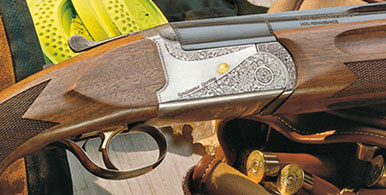
Franchi brought out a Renaissance Sport over/under in a 20-gauge. The coin-finished receiver includes ornate scroll work while the oil-finished stock is made of A Grade walnut. The suggested retail price is $2,349.
Winchester introduced the Walnut SX3 20 gauge at a starting price of $1,199. The All-Purpose Field model in 12 gauge is now available with a new Mossy Oak Break-Up Infinity Camo finish for $1,469.
CZ USA, the American arm of the Czech gun maker, brought out a new ultralight 12-gauge over/under called the Upland Ultralight. Its light alloy receiver brings down the weight to 6 pounds – 2 pounds lighter than the steel-frame versions. The new shotgun starts at $749.
Weatherby expanded its SA-08 line with two new models: the Deluxe and Waterfowler. The Deluxe features a high-gloss walnut stock and blued metalwork. It’s available in both 12- and 20-gauges models for $739. The Waterfowler has a camo synthetic stock and is only available in 12 gauge. It sells for $699.
We’re already looking forward to next year’s SHOT Show, to be held at the same venue on January 18-21. Stay tuned.
Irwin Greenstein is the Publisher of Shotgun Life. You can contact him at contact@shotgunlife.com.
Useful Resources
{loadposition signup}
Peer Review: The Fausti Dea Round Body and the Fausti Caledon
Written by Irwin Greenstein with the opinions of Terry Crawford, Rick Cundiff, Josh Lepman, Darrell McKigney, Mark Polek and Joe Svach
Clays Shooting Bliss at Seven Springs
How about a big, juicy Beretta Burger?
Or maybe a spicy Krieghoff Crabcake Sandwich is more to your liking.
Want something with a little more roughage? You can always order the Shotgun House Salad with lots of greens and homemade dressing.
These are some of the menu selections from The Grille at the Sporting Clays Lodge of the Seven Springs Mountain Lodge in Seven Springs, Pennsylvania. You can chow down in the classic chalet setting or grab a table on the 7,000-square-foot deck with a dazzling view of the valley below.
Peer Review: The SKB GC7 Clays 20/28/.410 Three-Barrel Set
SKB is a shotgun company that flies under the radar of most wing and clays shooters, which is regrettable given the enthusiastic impression the GC7 Three-Barrel Set made on the Shotgun Life Peer Review Posse.
Peer Review: The Krieghoff Essencia
Even though the Krieghoff Essencia took the Silver Award at the 2003 “Gold Medal Concourse d’Elegance of Fine Guns” and won the Shooting Sportsman Award for a contemporary, custom-fitted gun that best typifies the upland hunting ideal, our Peer Review group approached the Krieghoff Essencia with a measure of skepticism.
Everyone seemed to be wondering the same thing…
3 New Shotguns Herald the Return of Verona to the USA
We’ve witnessed the revival of shotgun legends in recent years, but based on our field tests of the three new Veronas, none have combined the affordability, reliability and performance as these Italian workhorses.
The resurgence of cherished shotgun brands has been most active in the over $10,000 market.
In 1999 we saw a return of the glorious Holloway & Naughton marque, which brought the British legend that was started in the early 1890s back into circulation for some $90,000 in a bare-bones, in-the-white canvas of shotgun artisanship.
The stunning Victorian-era English Boswell was resurrected by writer, instructor and impresario, Chris Batha, with prices that begin in the neighborhood of $45,000.
And you could buy a reproduction of the legendary A.H. Fox shotgun with its entry-level price of $15,500. Or the same company, Connecticut Shotgun, will sell you a reproduction of another side-by-side great, the Winchester Model 21, also starting at $15,500.
When it comes to shotgun revivals you can’t escape the feeling that this is a club for trust-fund babies.
But Legacy Sports International has chosen a different path when it came to reintroducing the Verona pedigree to the American shotgun scene. The new Veronas now favor hunters and clays shooters who hanker after an Italian icon with a Main Street price tag.
Verona’s new over/under and side-by-sides embody the classical look-and-feel that have served generations of independent shotgun owners. The new Verona semi-automatics, meanwhile, pose a direct challenge to the inertia-driven shotguns from the other Italians, Benelli and Franchi
In short, the many qualities that made the first Veronas a go-to shotgun for thousands of American sportsmen have been inherited by the new Veronas.
The management team at Legacy Sports International jumped at the chance of resurrecting the beloved Italian brand that has quietly become a mainstay to thousands of American sportsmen.
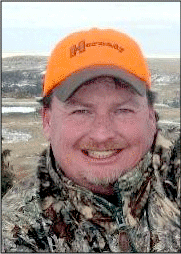
“The original Veronas initially came into this country in the late 1990s and early in 2000,” explained Andy McCormick, the Vice President Marketing and Sales at Legacy Sports. “We discovered that the name was available again and when we trademarked it we decided to take the Verona back to its Italian roots. Everyone seemed to be happy that the Verona brand was coming back into the United States.”
Like their older siblings, the new Veronas are dependable shotguns for real people. They are fully capable of putting meat on the table year after year. This fine hunting tradition is in keeping with both the original Veronas and the folks at Legacy Sports who are serious hunters.
The new Verona over/unders come from the original factory in Italy operated by Fabbrica Armi Isidoro Rizzini, or F.A.I.R. as it’s known, in the Brescia region of Italy. Brescia is the cradle of the centuries-old, Italian gun industry.
Brescia is home to celebrated gunmakers such as Beretta, Perazzi, Fabbri, Fratelli Piottti, Rizzini and Abbiatico & Salvinelli.
It is here, in this exquisite valley, that F.A.I.R. got its start in 1971. F.A.I.R. now operates a 43,000-square-foot, state-of-the-art operation that houses everything from its own R&D group to CAD-CAM simulations to software-driven lathes that meet space-age tolerances.
The finishing can often end up in the skilled hands of a craftsman descended from the Medieval arms makers of the region.
Legacy Sports turned to another pillar of Brescia for the new semi-automatics. These guns are made by F. Lli Pietta. The company touts its expertise in making historical weapons such as Western-style revolvers, muzzleloaders and period rifles. It had an existing relationship with Legacy Sports, which clearly proved Pietta had the chops to make a modern semi-automatic with old-world TLC.
Legacy Sports turned to Fausti Stefano for its new side-by-side. The Brescia manufacturer has been in business since 1948 and sells shotguns all over the world. Its ultra-modern plant allows the company to produce quality shotguns at affordable prices with hand finishing by local artisans.
Although the Veronas are brand new shotguns, Legacy Sports has found a way to successfully mine a vein of expertise that stretches back hundreds of years.
In the spirit of continuity, Legacy Sports recruited Verona’s original gunsmith. As luck would have it, he had recently moved to Carson City, Nevada – a stone’s throw from Legacy Sports’ Reno operation.
“He was the Maytag repairman,” McCormick joked. “He did all the warranty work and maybe he’d get a cracked stock once in a while. That was about it.”
Having shot all three of the new Veronas, we can only surmise that not much will change for their gunsmith.
It was too early for bird season, but we did manage to get the guns out for skeet, 5 stand and sporting clays and they all felt rock-solid.
The Verona 401, 405 and 406 Semi-Autos
Verona’s inertia-operated semi-autos are available in 12 and 20 gauge, with either wood or synthetic stocks. The wood models come with 3-inch chambers while the synthetic models are also available with or 3½ inch chambers for 12-gauge only.
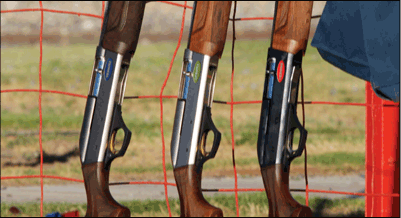
The wood versions will be available in three receiver finishes: blued, nickel and grey. We shot one in grey that had the traditional green Verona oval rendered in blue, and it was a handsome combination evocative of one of the most elegant and contemporary looking receivers in the shotgun universe, the Blaser F3.
Features:
¨ Chrome-lined barrel internally choked for steel shot
¨ 12-gauge barrel length of 28 inches; 20-gauge barrel length of 26 inches
¨ Brass sight on standard model; fiber optic on deluxe model
¨ Pivoted head bolt with integral double-charging lever and sleeve
¨ Oil-finished walnut stock and forend with checkering
¨ Black nylon recoil pad
¨ Patented locking forend
¨ 4 + 1 magazine capacity
¨ Length of pull 14¾ inches
The MSRP for the 12 gauge and 20-gauge Verona 401 varies between $1,199 and $1,250 depending on finish.
The Verona 405 is basically the Verona 401 with a black synthetic stock and forend and a blued receiver. The MSRP on the Verona will be forthcoming.
The Verona 406 is the model that handles 12-gauge, 3½ inch magnums. It’s finished with a black synthetic stock and forend and a blued receiver and has an MSRP of $1,199.
The Verona 501 and 702 Series Over/Unders
Named after the original over/under, the new Verona 501 Series field gun is distinguished by its nickel receiver. Standard features include:
¨ Enhanced walnut stocks with Scottish net-type checkering and oil finish
¨ Select fire single trigger
¨ Automatic ejectors
¨ Bottom locking bolt system on double trough
¨ Double sculptured receiver head
¨ Boxlock action
¨ Monobloc barrel construction
¨ 5 flush-mounted chokes (F, IM, M, IC and SK) and a choke key
¨ 28-inch chromed barrels with the X-CONE System (lengthened forcing cones) to reduce felt recoil
¨ Partially vented rib
¨ Fiber-optic front bead
¨ Solid lateral ribs
¨ Steel actions with automatic safety
¨ Ventilated rubber recoil pad
¨ Length of pull 14¾ inches
The Verona 501 Series is available with 28-inch barrels in 12, 20, 28 gauge and .410 models – all with an MSRP of $1,670.
A Verona 501 Series Combo set in 20/28 gauge has an MSRP of $2,599.
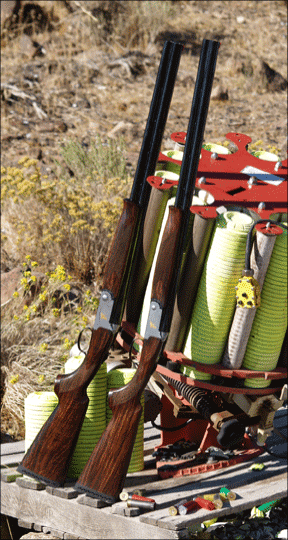
There is a higher grade Verona 702 Series, which is the one that we shot (more on that in a moment). It features more embellishment on the receiver, trigger guard and elsewhere on the gun. The Verona 702 Series has an MSRP of $1,780.
A great feature about both these guns is that they can handle 3-inch magnum loads, making them ideal for wingshooters with a flair for over/unders. The 12 gauge weighed in at seven pounds (with the smaller gauges getting progressively lighter), making it a nice compromise between basic heft for the recoil absorption of 3-inch magnums and easy lugability in the field.
The Verona 662 Side-by-Side
The 12-gauge version of Verona’s new 662 side-by-side upland shotgun packs the wallop of 3-inch magnums like its over/under brethren. That means, not only can you take this gun anywhere, but you’ll raise some eyebrows when you make shots that most would think impossible with a side-by-side that shooters assume is maxed out with 2¾ inch loads. In the vernacular of a muscle car, this baby is a sleeper.
Standard features of the Verona 662 side-by-side include:
¨ Boxlock compound-steel action
¨ Single trigger
¨ Color case-hardened receiver with fine laser engraving
¨ Reliable Anson-type forend mechanism
¨ 5 flush-mounted chokes (F, IM, M, IC and SK) and a choke key
¨ 28-inch barrels with concave rib (26-inch barrels on the 28 gauge)
¨ Oil-finished English-style walnut stocks and semi-beavertail forends, both checkered.
¨ Rubber recoil pad
¨ Weight of 6 pounds, 4 ounces
¨ Length of pull 14½ inches
The 12 gauge and 20 gauge models of the Verona 662 share an MSRP of $2,187. The 28-gauge model has an MSRP of $2,800.
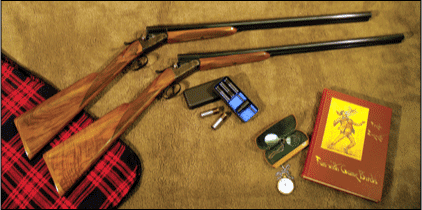
Shooting the New Veronas
We had the unique opportunity to evaluate each of the new Veronas for some hard-core shooting. Since there’s not much bird shooting in the middle of June, we instead took the shotguns out for several rounds of sporting clays, 5 stand and skeet.
We’ll get to the individual shotguns in a moment, but uniformly they shared a very solid feel. Nothing wobbled when you closed the over/under and side-by-side. The barrels met the frame with an authoritative thud.
On the semi-automatic, the forend tightened down firmly. The joints between the receiver, spacer and stock were also tight.
Overall, the wood-to-metal finish on the shotguns was very good.
Shooting Impressions of the Verona 401 Semi-Auto
When Verona departed from the gas-operated actions of the previous 401s, Legacy Sports decided to take on the inertia champs, Benelli and Franchi.
We loaded 1? ounce Estate shells into the chamber and once we started shooting our first impression was that the Verona 401 seemed a little quieter than the Benellis. For an inertia-operated shotgun with a conventional wood stock we were also surprised at the low recoil.
The Verona 401 was deadly accurate, the slim receiver giving you a clear runway view along the rib and beyond the fiber-optic sight straight at the target. We found that this played well into intuitive shooting in terms of easily following the target to the desired point of impact.
With a smooth recoil pad and 14¾ inches length of pull, the Verona 401 came up without a hitch.
However, the Verona 401 felt a little nose-heavy to us, but so many shooters prefer that dynamic to maintain their swing we can only chalk it up to our own little subjective quirk.
The scalloped checkering and forend shape contributed to a sold and controlled grip. Likewise, the pistol grip of the stock was the perfect diameter so that our middle finger and thumb could meet as we held the shotgun. It also placed the front joint of our trigger finger comfortably on the trigger. The trigger pull was short and crisp, we figured coming in at around four pounds. Basically, the ergonomics of the Verona 401 were excellent.
Speaking of ergonomics, our favorite feature was the placement of the breech bolt release button. Most semi-autos have it on the right hand side, under the ejection port. The placement of the button on the Verona 401 is on the left side. Initially, this struck us as odd until we discovered that your right forefinger naturally finds it. We liked that a lot.
Shooting Impressions of the Verona 501-702
The gun we received from Legacy Sports was the more decorative 702. It featured 80% coverage of the floral engraving with gold inlaid birds on both sides and the bottom of the receiver. The rounded half-sideplates and floral hinge pins created a classical fascia that complemented the Schnabel forend.
While the walnut was in keeping with a shotgun for this price range, ours had a rich, dark hue with a stratification of tan and chocolate grains. The oil-finished stock and forend were perfectly matched.
The shotgun’s center of gravity felt exactly where your left hand held the forend – directly ahead of the receiver. This was ideal for shooting low gun, since the weight in your left hand facilitated you drawing the gun straight up and out until the gun was properly mounted on your shoulder and face.
At the same time, the angle and diameter of the pistol grip helped prevent you from see-sawing the gun – meaning that you lift it by the stock and consequently drop the muzzle.
Ultimately, the gun came up every time consistently for a smooth shot and follow-through.
We found the auto-safety to be intrusive for clays shooting, but remember as a field gun it would be essential. The shotgun had a single selective trigger and automatic ejectors, which should really be expected for shotgun in this price range.
The gun shot flat and true with unremarkable recoil for our 1? ounce loads.
All we can say is that we wished we could’ve gotten this shotgun out in the field with a bunch of birds. It would’ve been a heck of a lot of fun to shoot.
Shooting Impressions of the Verona 662
We much prefer interchangeable chokes to double triggers in our side-by-sides and so we approached the Verona 662 already endeared to it. The semi-beavertail forend that helped prevent you from burning your hands was icing on the cake (and we think that deep down inside those guys who shoot vintage side-by-sides with those splinter forends that barbecue your fingers would really like to step forward and give us a big huzzah).
We keep hearing about effete Europeans who make these impossible wingshooting shots with their 28 gauge and feel compelled to admonish us Americans for overkill (as in big ammo, big cars and big food). For those of the European school of shooting we politely say, Go away. The Verona 662 is clearly a side-by-side for American sportsmen who relish overkill.
Despite its straight English stock and case-colored receiver with fine floral engraving, the Verona 662 loaded up with 3-inch shells is a shotgun that you want to use on big, stubborn birds. Pheasants come to mind, and if you’re a pigeon shooter with a penchant for side-by-sides you should buy the Verona 662 now.
We savored shooting the Verona 662 for the sheer, raw power it exuded. At the same time, the gun never ran away from you; the straight stock and broad forend worked together for an empowering and accurate shooting experience.
Our only gripe with the Verona 662 was the lack of a selective trigger. Like the Verona 702, it also had an auto-safety that proved inconvenient during clays shooting. But part of that problem was our own enthusiasm in really wanting to shoot the heck out of the Verona 662.
Wrap Up
With the Verona 401 coming in at about $400 under the Benelli Legacy and a similar price as the Franchi I-12 Upland Hunter, it merits serious consideration for wood-finished, inertia-driven semi-autos.
The Benelli Legacy has more engraving while the Franchi I-12 Upland Hunter has a look that we think is bit more stodgy. The Benelli and Franchi are certainly celebrated for their reliability, but Verona’s own track record as a manufacturer of shotguns that go the distance certainly speaks to it own quality.
When it comes to the Verona 501-702, the price, quality and dependability pretty much put the guns in a class of their own. But does that mean you should buy the Verona a 501-702 on price alone? Chances are you are familiar with the most popular new over/unders in the $2,000 – $3,000 category. We believe the Verona 501-702 stands up for its workhorse virtues and classical looks – plus it will handle 3-inch magnum shells. From our perspective, that makes for a compelling package.
The Verona 662 has also carved out its own niche in the under $3,000 side-by-side market. Obviously, the Verona 662 is not for the breeks set. But with its 3-inch-shell capability, straight stock, interchangeable chokes and single trigger it would be hard to find a side-by-side that delivers more pure fun.
Irwin Greenstein is Publisher of Shotgun Life. You can reach him at letters@shotgunlife.com.
Useful resources:
Legacy Sports International/Verona Shotguns
{loadposition signup}
Doug Oliver: The Keeper of the 16-Gauge Flame
Anyone who shoots a 16-gauge shotgun should send Doug Oliver a big cigar.
As founder of the 16 Gauge Society, Doug has been keeper of the flame for a shotgun orphaned by the industry.
Over the years marketing decisions within the shotgun industry have relegated the 16 gauge from the second-most popular shotgun to an icon of perfection among a small band of bird shooters. They marketed the smaller 20-gauge rival, despite the superior ballistics of the 16 gauge. At the same time, the 12 gauge has been gentrified from its bruiser, meat-market heritage to a relatively comfortable, all-purpose shotgun.
The world of tournament shooting has also conspired against the 16 gauge. Simply put, there are no 16-gauge competitions in major clay-shooting events – depriving the 16 gauge of the credibility and high-profile marketing opportunities to sustain a thriving market.
Still, the perseverance of devoted 16-gauge shooters has kept the shotgun alive. And you could easily make the case that Doug has emerged as the voice of the 16-gauge shotgun community.
“If I were trapped on a desert island, I would want the 16 gauge, because it won’t beat you up and it kills birds without killing you,” Doug said.
Maybe it’s a confluence of happy circumstances that Doug, who owns a graphic-design firm in Bell Canyon, California, fell in love with 16-gauge shotguns to the extent that he started the 16 Gauge Society web site.
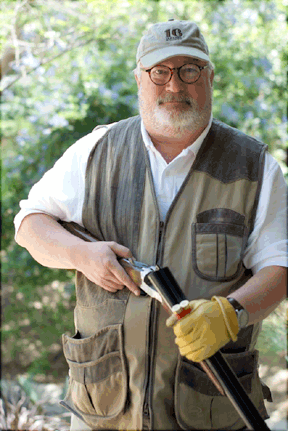
Doug Oliver
He fondly recalls shooting 16-gauge shotguns as a kid in Newton, Kansas with his father.
“From the age of 10, I started hitting birds, and I became joined at the hip during bird season with my father. We’d hunt quail, pheasant, doves…,” he said.
During that period, he started out with a .410, and passed through a 16 gauge on his way to a 12 gauge. He remembered liking the 16 gauge, although for the bigger part of his life he shot 12 and 20 gauge.
“The 16 gauge is absolutely the perfect shotgun,” he explains. “It has a perfect load for wingshooting. Plus a 16 gauge will typically be a pound lighter than a 12 gauge if you’re carrying it all day in the field. The 16 gauge shoots like a 12 gauge but carries like a 20 gauge. It’s a great gun.”
When Doug turned 50, for his midlife crisis instead of a Porsche he bought himself a shotgun. It was a 16-gauge F.A.I.R. Rizzini over/under. It was a better gun than he had known at that point.
On a flight from Los Angeles to New York, he had been reading an article in Double Gun Journal about dove hunting in Argentina. Until that point he had every intention of buying a 20 or 28 Beretta, but the article deflected him to the 16-gauge F.A.I.R. Razzing.
Doug found himself smitten by the lovely 16 gauge. In doing his “homework” for that 16-gauge F.A.I.R. Rizini he realized “that 16 gauge was a stepchild,” he explained. “Information at the time was so hard to dig out and that’s where the 16 Gauge Society web site came in. I though I’d just design and throw up 16 gauge web site and maybe sell a couple of hats. The project itself was fun and informative.”
After a few months of hard work, the 16 Gauge Society web site went up in 2002 at http://www.16ga.com.
It now has approximately 1,500 members of the 16 Gauge Society, plus another 2,400 people who frequent the site’s forum which serves as a clearing house of information for everything 16 gauge. Over 60,000 posts have been recorded on the site.
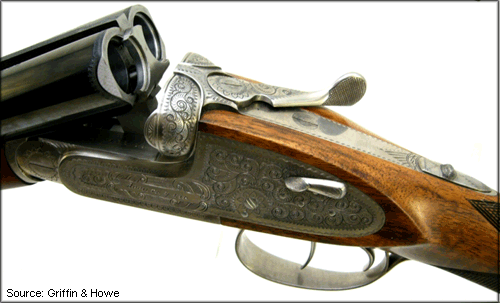
As Doug relates about the forum “You can throw a question out about a gun and 10 guys will answer you – civilly.”
There is a one-time, lifetime $25 membership to the 16 Gauge Society. But for Doug, the organization “is not a moneymaker. It’s a passion.”
Last autumn, one of the members of the 16 Gauge Society organized a pheasant shoot in North Dakota. A dozen or so members met for the first time there. “It was fun, everybody got pheasants,” he said. “A good time was had by all.”
In a way, that was a trip back to the good old days of 16-gauge hunting.
Doug is an active 16-gauge shooter. Of the 10 shotguns he currently owns, four of them are 16 gauge. He still has that F.A.I.R. Rizzini, in addition to a 1959 Beretta Silverhawk and two Browning Sweet 16 A-5s.
He recalled that when he began hunting there were a lot of 16-gauge shotguns on the market. Winchester Model 12s, Ithaca and Remington pumps, and the Browning Sweet 16 A-5s dominated the market, alongside a smattering of Fox, Parker and L.C. Smith doubles.
Although many a young hunter was started in the field with a 16 gauge, by the late 1950s and early 1960s, the 20 gauge, and later the 20-gauge 3-inch magnum, simply buried the 16 gauge shotgun in the U.S.
Doug now thinks that the 16 gauge is experiencing a renaissance. “After a 50-year decline in popularity, the sixteen is making a well-deserved comeback. And in a number of production lines, too.”
Today, although sometimes difficult to find, the industry still offers the standard and high-velocity lead and non-toxic loads from all major manufacturers. “Yet even though this situation has improved in the last few years, most serious 16-gauge shooters custom hand load their own shells. This is true of many shooters regardless of gauge,” Doug observed.
Affordable 16-gauge shotguns are available from a number of manufacturers including Griffin & Howe, Arietta, A. H. Fox, Browning, Connecticut Shotgun Manufacturing Company’s Model 21, Cortona, Arietta, Dean, Grulla, Stoeger and a handful of others.
And of course, there are also thousands of used 16-gauge shotguns in search of a new home.
Noe Roland is a frequent contributor to Shotgun Life. You can reach him at letters@shotgunlife.com.
Useful resources:
http://www.arrietashotguns.com/
http://www.connecticutshotgun.com/ahfox1.html
http://www.connecticutshotgun.com/model21.html
http://www.cortonashotguns.com/
http://www.grullaarmas.com/es/
http://www.stoegerindustries.com/
{loadposition signup}
Peer Review: The Benelli Supersport 20-Gauge Semi-Auto
Benilli must be the sexiest brand in shotguns today.
Stainless steel, carbon fiber and the jet-fighter silhouette make Benelli semi-autos all the rage. Yet the underlying engineering is the big payoff.
How I Shot With the Stars
Most people agree that baseball is the all-American sport. But after spending three days in San Antonio, Texas at the National Shooting Complex, I would argue that the sport which best captures the heart and soul of the American spirit is skeet.
Professional baseball has been battered by drug scandals, crass commercialism and outrageous salaries – giving a black eye to the American core values of fair play, self-determination and mutual respect.
By contrast, tournament skeet remains firmly in the stronghold of the shooter who competes for the love of their sport and a burning desire to win fair and square. While these birds certainly don’t have feathers, the hunger is still there to feed that great American quality of redemption – that you can always pick yourself up by the bootstraps to make a comeback target by target. It’s the grit of the individual and their gun forging their own destiny.
While professional baseball now finds itself pulsing through the digital infrastructure onto big-screen TVs and multi-media web sites, skeet holds fast to the ideals of craftsmanship in the hand-finished shotguns that still produce a streak of 500 or more consecutive broken targets.
Although the predecessor to the baseball bat may have helped primitive man fend off sabre-tooth tigers, it is the gun that won the American West – a part of the country I found myself in for three days in March.
As an avid recreational clays shooter, I became immersed in tournament skeet through a remarkable program developed by the National Skeet Shooting Association (NSSA) – the sport’s nonprofit governing body.
The NSSA and its sister group, the National Sporting Clays Association (NSCA), in conjunction with the state-level associations, keep track of just about every major skeet and sporting clays tournament in the U.S. The NSSA-NSCA is the repository for all registered scores shot in both large and small clubs throughout the country and in the world.
NSSA shooters often enter the realm of tournament skeet through grass roots organizations such as the 4H, which actively promotes skeet competition; through various instructors who want to see a promising student take their skills to the next level; or through local clubs where the NSSA sanctions competitive shoots.
But NSSA member, Stuart Fairbank, saw another way of opening the door of tournament skeet to recreational shooters. It’s called Shoot with the Stars, and it has been held at the annual Toni Rogers Spring Extravaganza, one of the earlier Top 10 shoots in the country that shooters use to open the tournament skeet season for three years. This year it took place March 27-29 at the NSSA-NSCA National Shooting Complex.
Although Stuart says the concept for this type of program had been around for the past 20 years, it was in 2007 that he teamed up with NSSA Secretary/Treasurer, Bob DeFrancesco, to really make it happen.
As Stuart explained it to me in the club house “There were always people who felt that the shooting games were exclusionary. They belong to a home club where they feel comfortable, but in terms of tournament shooting they have a hard time getting started. It can be confusing at first especially when you travel away from home and don’t know anybody at the shoot. And there’s the apprehension associated with meeting, and being squaded with, and competing against the big shooters. We want to make it as easy as possible for the new folks to experience a first-class tournament, meet and shoot with some of the best in the game, and do it all on manageable budget.”
For example, for someone like me who’s managed to shoot his fair share of 25 straight in skeet, it would be an absolutely intimidating proposition to go up against the likes of some of this year’s stars…
- Sam Armstrong, whose 12-gauge average in 2008 hit 0.9920 (meaning that he broke slightly more than 99 out of 100 targets in each competition).
- Dave Starrett, whose 12-gague average in 2008 was 0.9963
- Billy Williams, who had a 2008 12-gauge average of 0.9907
- Tami Meyers, with a 12-gauge average of 0.9826 in 2008
- Bob DeFrancesco who racked up a 20-gauge average of 0.9958
Of course registered tournaments do not directly pit the new shooter against these stars, or the other stars who participated in the program including John Shima, Stuart Fairbank and John Herkowitz. A classification system that ranges from top-ranked AAA to E shooters ensures competitive equilibrium. I had been ranked D, given that I had registered for a single tournament skeet shoot in 2007.
Turns out, I was exactly the kind of shooter that Stuart wanted to attract through Shoot with the Stars.
Stuart believed that the sport needed to create “ambassadors,” or recreational skeet shooters who were given the opportunity to mingle with the stars, and then go home and spread the good word.
So in 2007, Stuart and Bob posted the first Shoot with the Stars call on the Internet, attracting three shooters. Over time, a selection process was put in place. The names of up to 27 shooters would be drawn – three from each of the organization’s nine regional zones.
This year there were 15 recipients including myself, since I was the only one to apply from Zone 2.
The 2009 sponsors were Ms. Toni Ann Rogers (Title Sponsor), Federal Ammunition, Browning, Rio Ammunition, Kolar Arms, Remington Arms (.410 bore), Winchester Ammunition (28 gauge), While Flyer targets, leathersmith Al Ange and the NSSA as sponsors.
With sponsors and organization in place, the 2009 Shoot with the Stars gave us newcomers 100 shells in each gauge (12, 20, 28 and .410 bore) for use in the competitions, plus they waived our entry fees in each event of $50 and the nominal target fees that came to $6 per day. The Shoot with the Stars program also provided the experience of a lifetime (for skeet shooters this is tantamount to playing golf with Tiger Woods).
My Shoot with the Stars adventure started when I landed at San Antonio International Airport at about noon on March 26th. After renting a car, I headed directly to Blaser USA in San Antonio, the U.S. arm of the German manufacturer that makes the marvelous F3 shotgun.

Having shot an F3 before, I knew it would be the gun to shoot. Here’s why…
- The F3’s 100% mechanical, single-selective trigger functions at a light 3.3-lbs trigger pull. The hammers of the F3 move in a linear plane – straight forwards and then backwards when the gun is re-cocked. Typically, most hammers pivot around the pin in a lower efficiency arc. This design gives the gun a crisp, confident feel every time you pull the trigger.
- You can adjust the trigger blade length for a precise fit.
- The gun’s Inertial Block System prevents double, or fan, firing. It’s coupled with a mechanical trigger group that doesn’t rely on recoil to set the second shot. If you get lucky and hit your first shot with a poofer, the next shot will fire regardless.
- The F3’s receiver measures a sleek 2.415 inches high at its tallest point, making it one of the lowest-profile shotguns on the planet. Blaser managed this engineering feat by streamlining the conventional lock. The gun’s low-profile receiver, and its low axis, help reduce felt recoil by directing the shock wave through the most dense part of the stock. This would be important in shooting 200 competitive rounds per day, plus several rounds of practice.
- The balancer in the stock is a cylindrical weight on a long threaded screw. You can move the weight up or down to find your perfect balance. The additional weight in the stock also helps absorb recoil.
- With Blaser’s Ejection-Ball-System, the ejector springs are cocked automatically when the shot is fired and the gun is opened. This feature virtually eliminates hulls sticking when you crack open the gun.
- The grip has a substantial palm swell.
- At 8 lbs, 7 oz, the gun has a near perfect weight for recreational skeet shooters (tournament skeet shooters are known to add weight that could bring their guns to over 9 lbs for controlled swing momentum).
Norbert Haussmann, CEO of Blaser USA, had arranged for me to pick up the perfect 12-gauge model for Shoot with the Stars. It had a Monte Carlo stock complemented by an adjustable comb. The barrels were 30 inches in length. The lid of the hard case held three sets of Briley Revolution tubes in 20 and 28 gauges and .410 bore. Along with a full set of chokes, Blaser packages this F3 as the American Skeet Combo. And I have to say, it is really impressive.
After a Blaser tech tweaked the comb for me, the gun came up just right. If ever I were going to shoot a great game of skeet, this F3 would be the shotgun to make it happen.
Mother Nature, however, had other things in store.
Before leaving for San Antonio, I had checked the weather. It was supposed to be sunny, mild and in the mid-80s. It didn’t exactly turn out that way.
The next morning saw prevailing winds of 20-30 mph with gusts to 40 mph. For a flying disc such as a skeet target, winds that high create crazy turbulence.
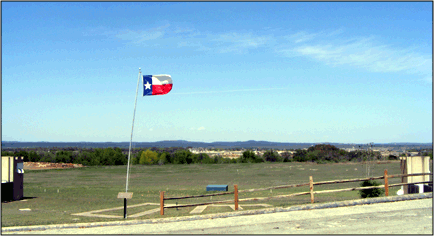
Air density, drag coefficient, angle of attack – everything is up for grabs as the wind blew across the open, flat terrain of the National Shooting Center.
If the target is going with the wind, it can race out of the trap house with an afterburner burst, and then get driven into the ground even before it reaches the opposite house.
If the target is going into the wind, it can simply rise and stall – one of the worst things that can happen to a shooter who uses momentum to swing through for the target break.
Then there’s the ongoing debate as to whether or not it’s best to break a target in the wind sooner or later. Some experts believe that you should break the target as soon as possible before the wind knocks it off the line of trajectory. Others, meanwhile, say you should wait until the target adjusts to the wind before pulling the trigger.
All I can say is that conditions were not great to shoot the first event of the tournament, which was doubles (when the high-house and low-house targets are thrown simultaneously).
Of the 45 skeet fields at the National Shooting Complex, I was slotted to shoot on number 9. My squad star would be perennial All American Sam Armstrong from Maryland. At least it was a 12-gauge event (imagine if it was .410).
Introductions and hand shakes all around among the five squad members and we were ready to shoot. During the 100-round event, I was surprised at the ongoing chatter of encouragement. If someone made a great shot, the others shooters in the squad let him know about it. When you stepped up to the station, you were given a pep talk – “You can do it…come on, get in the groove, crush ’em now…”
Turns out it was the unspoken code among tournament skeet shooters. You helped your competitor achieve their fullest potential in the preliminaries and then faced him head on in the shoot-offs. This friendly banter contributed to a real sense of family among the shooters – even for a newcomer like me.
For Sam and the other highly ranked shots, doubles took on a beautiful cadence: BANG…1 Mississippi…BANG. It was the veritable heartbeat of doubles. Consistently, they knew the rhythm of the game and mastered it.

My final score was 57. Not great. It turns out, I made a couple of mistakes when it came to shooting in strong winds, which were explained to me over dinner that night with Sam and his friends at a Saltgrass Steakhouse.
First, by following the school of thought that says you break the targets close to the house in the wind, I held the Blaser further back than usual. The gun swung so beautifully, I figured it would be no problem nailing that target right out of the house before the wind could grab it.
I found out afterwards that you do just the opposite when shooting in the wind. You hold further toward the center stake. By reducing your gun swing, you stand a better of chance of breaking the target as it slows down, as opposed to attempting to shoot it when it comes accelerating out of the house.
Another mistake I made was shooting the target when it stalled in the wind. For example, if I were shooting the low 1, and it stalled right in front of me, I ended up missing the target. I was wondering how was that was possible? After all, the target was stopped dead; it was close enough to be hanging right off the brim of the cap. How the heck could I possibly miss that target?
The answer was simple: I had unconsciously lifted my face off the stock to look at the unusually high targets. Break that seal between your cheek and the stock and you’ll miss the target every time – even if the bird is dangling three feet in front of you.
My third mistake was trying to measure the target lead in the wind. If you look for the lead, you invariably take your eyes off the target – or worse end up glancing at the front bead. Either way, the target will get away from you.
OK, lessons learned. But would they stick? Let’s see how I would shoot the next day.
Right after the alarm clock went off, I checked the weather on my iPhone. Wind was blowing at 15 mph, with gusts reaching 23 mph. Certainly challenging, but not as daunting as the day before.
When I arrived at the National Shooting Complex that morning, one word dominated the communal conversation: wind. One of the stars confided later that he had not missed a single 12-gauge target since August 2006 – until doubles the day before when he shot a 98.
Other top shooters said “the wind got to me.” What did they mean by that? A strong, relentless wind can make you tense your muscles, slowing you down. Likewise, a sense of exhaustion sets in, both physically and mentally. Unlike them, I never expected to shoot 100 straight, often the threshold for entering the shoot-offs. While a 97 or a 98 would be great for me, it was unacceptable in the rarefied ranks of AAA skeet champs.
I had two events scheduled for that Saturday. I would shoot 12 gauge at 10:30 and 28 gauge at 3:00. I was optimistic. At least 12 gauge gave me the firepower for a wider margin of error in the wind. When it came to 28 gauge, I’d been shooting it for the past year at my local club. I think it’s the perfect gauge for skeet, and I had recently nailed my first 25 straight in 28 gauge.
Stuart Fairbank, a multiple World Champion from Connecticut, turned out to be the star of our 12-gauge squad. An affable guy, he really kept up the chatter – giving the squad a positive vibe through all 100 rounds. My final tally for the event was 81. I have to give ample credit to the Blaser for what I thought was a good score. It performed flawlessly, giving me great site pictures, a controlled swing and a comfortable shooting experience.

With a few hours remaining until the 28-gauge event, I paid a visit to the NSSA-NSCA Museum on the grounds. The museum included a history of skeet with wonderful artifacts. There were Hall of Fame Photos for both skeet and sporting clays and some entertaining videos to watch.
After the Museum, I walked across to the concession and ordered a tasty pulled-pork sandwich. I took the sandwich onto the patio and watched the other events as I ate.
At about 1:30, I installed the 28-gauge tubes from the trunk of my rental car. They went in like butter. After I shot two practice rounds, I knew 28-gauge would be intimidating.
Everyone says that regardless of the gauge, you always shoot the target the same way. Keep your hold points and break points consistent, whether it’s 12 gauge or .410. However, here’s the rub: A standard 12-gauge 1-1/8 oz shell with #9 shot holds about 658 pellets. A standard ¾ oz, 28-gauge shell with #9 shot has about 439 pellets – or nearly 50% fewer pellets. For the highly ranked shooters, the lower pellet count wouldn’t make that much of a difference. But I needed all the help I could get as the sundowner wind started to kick up, fulfilling the prediction of 23-mph gusts. In the end, I shot a 67.
My 28-gauge star was multiple World Championship winner Billy Williams from Montana, the only one of two shooters to score perfect 100’s in doubles the day before. Throughout the event, Billy was a master of encouragement, leading the squad in a chorus of positive banter. Even with my less-than-stellar 67, it was a joy to shoot in that squad. By now, I was starting to feel like an NSSA son-in-law.
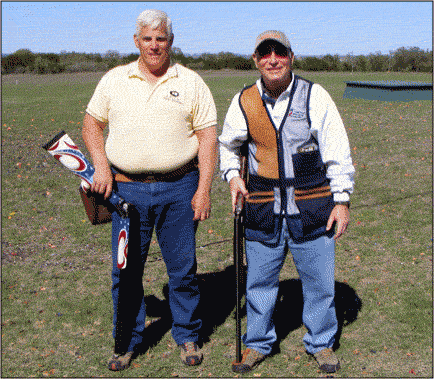
That night, the Party on the Hill was held in the massive Beretta Pavilion. A Mariachi band entertained as free Mexican food, cocktails and beer from a keg were served. From this vantage point, you could look down across the great expanse of the National Shooting Complex and the Hill Country Beyond. It was a clays shooting paradise.
Sunday morning saw me slotted for two events. At noon, I would shoot 20 gauge with star, Bob DeFrancesco, NSSA Secretary/Treasurer and many time All American from Connecticut. My .410 event would take place at 4:30 with star, Dave Starrett, another multiple World Champion winner from Ohio. The weather was a hold-over from the day before: 14-mph winds, gusting to 25 mph. In the 20-gauge event, I scored a respectable 75. My score for .410 score came in at 63.
What did I walk away with from my Shoot with the Stars experience?
For one thing, I learned that Stuart was absolutely right about the experts who volunteered as this year’s stars. Every one of them was approachable, supportive and basically just a really nice person. Second, it rekindled my desire to shoot registered skeet at my local club. I discovered that the competition simply makes you shoot better. You keep a razor-sharp focus on the targets, you pay more attention to foot placement at each station and you shot the birds more aggressively – breaking them sooner. Finally, I learned valuable skills that I could apply just when I’m hanging out and shooting skeet with friends.
Tournament skeet is not for every shooter. But sometimes you just don’t know until you give it a try. Based on my experience, I would urge any skeet shooter to give tournament shooting a test drive. Join the NSSA and find a club near you that holds registered shoots.
In the end, I had only one regret about my trip to San Antonio: it was having to return the Blaser F3. That shotgun sure was a keeper.
Irwin Greenstein is Publisher of Shotgun Life. Please send your letters and comments to letters@shotgunlife.com.
Helpful resources:
Shotgun Life Newsletters
Join an elite group of readers who receive their FREE e-letter every week from Shotgun Life. These readers gain a competitive advantage from the valuable advice delivered directly to their inbox. You'll discover ways to improve your shooting, learn about the best new products and how to easily maintain your shotgun so it's always reliable. If you strive to be a better shooter, then our FREE e-letters are for you.
About Shotgun Life
Shotgun Life is the first online magazine devoted to the great people who participate in the shotgun sports.
Our goal is to provide you with the best coverage in wing and clays shooting. That includes places to shoot, ways to improve your shooting and the latest new products. Everything you need to know about the shotgun sports is a mouse-click away.
Contact
Irwin Greenstein
Publisher
Shotgun Life
PO Box 6423
Thomasville, GA 31758
Phone: 229-236-1632











